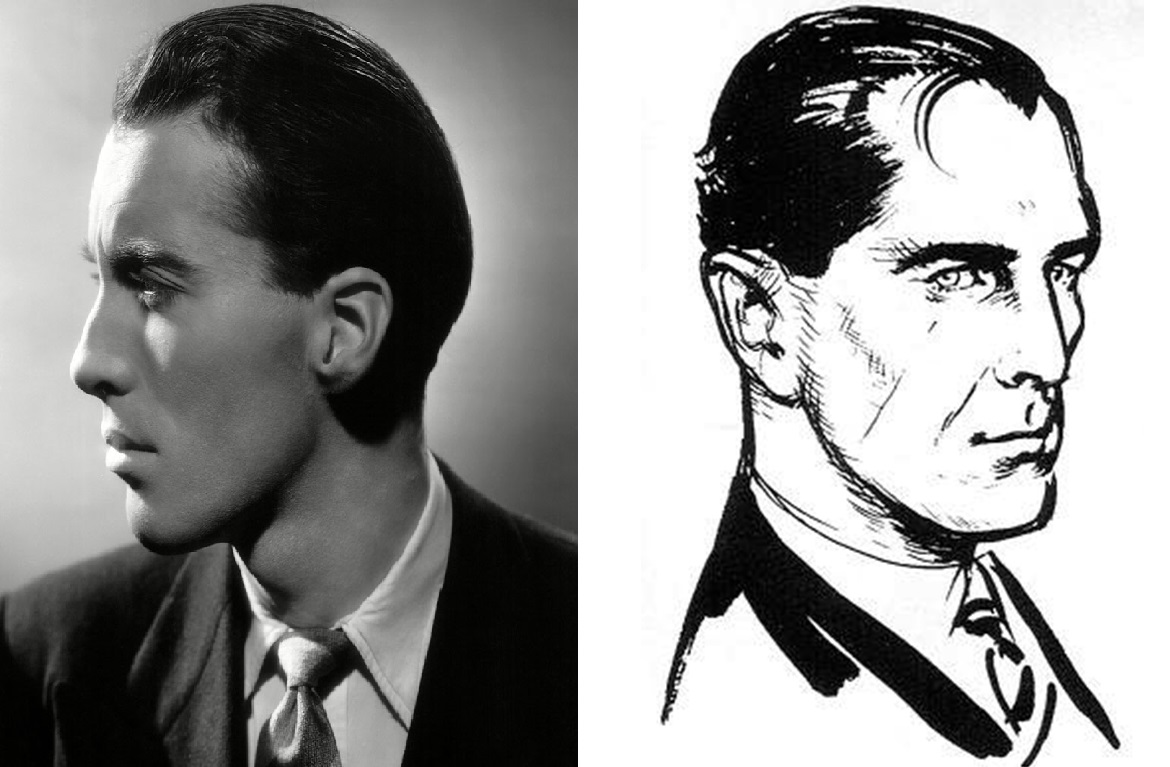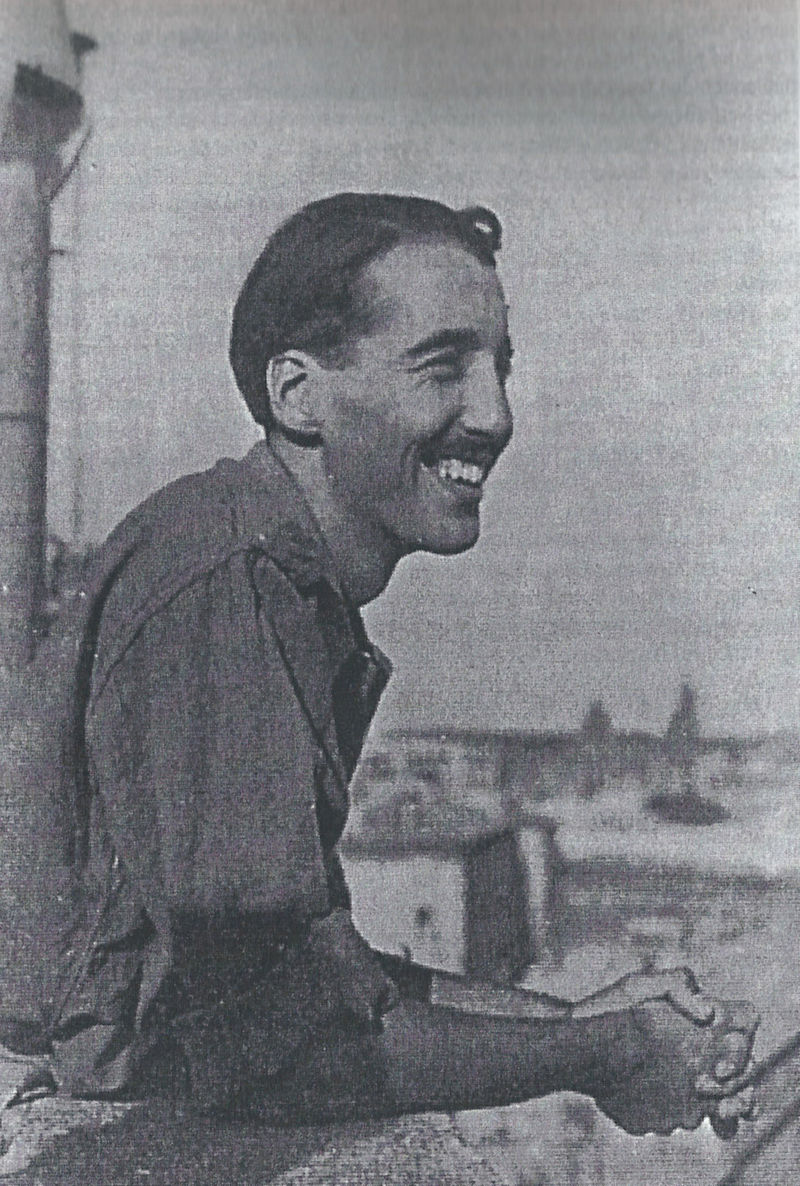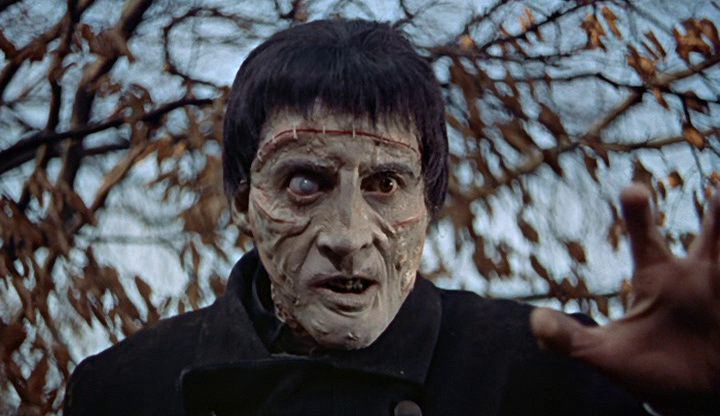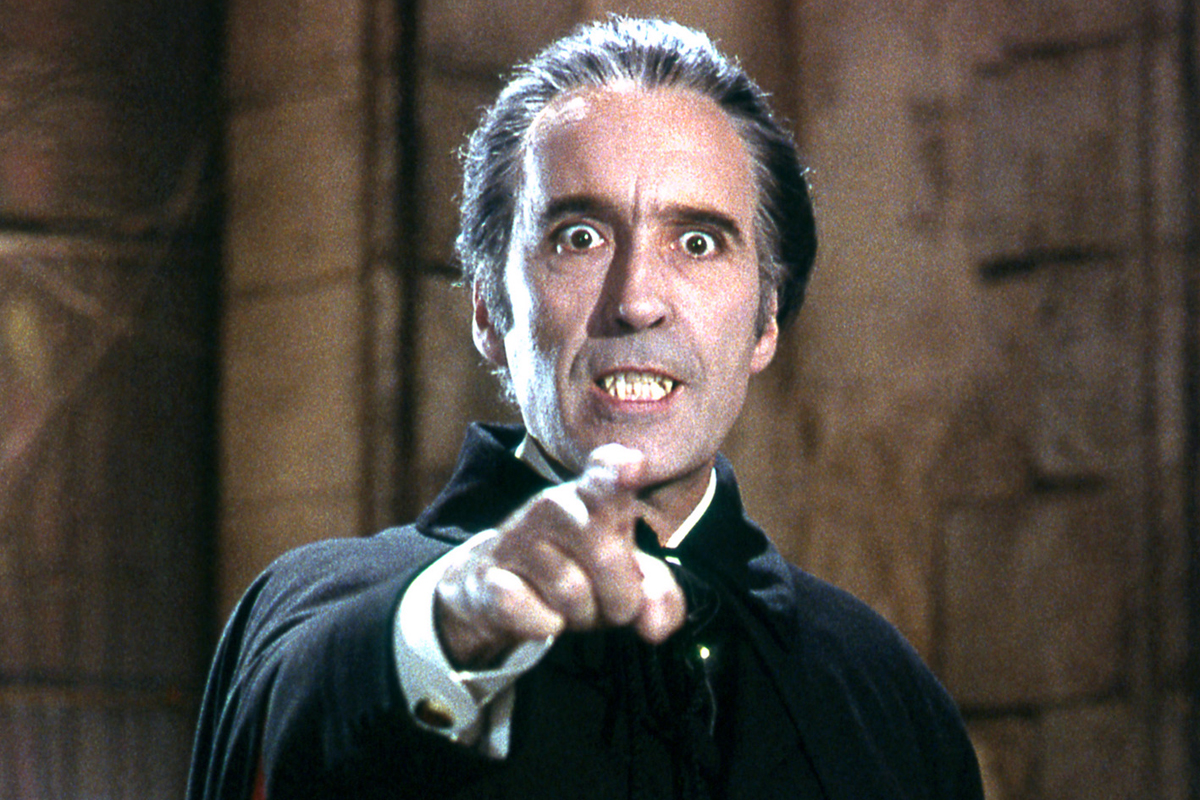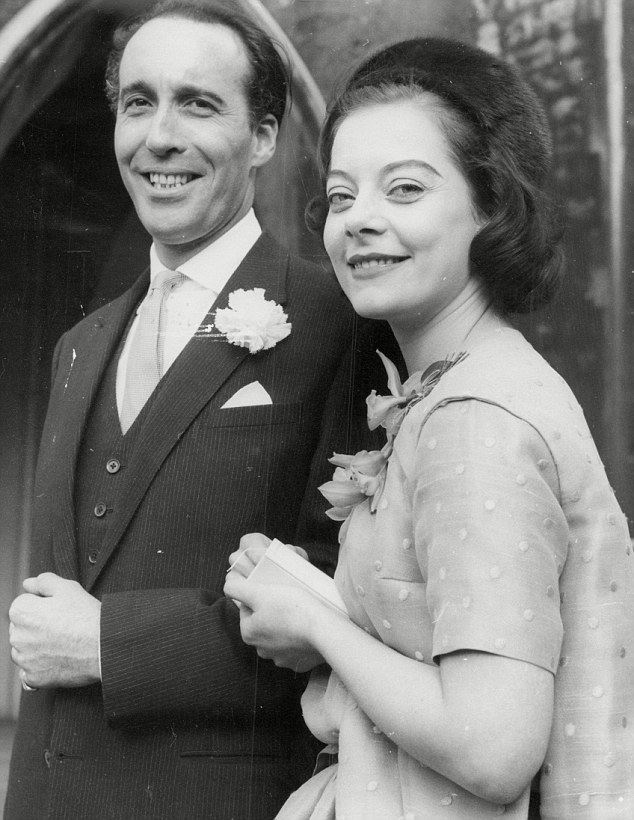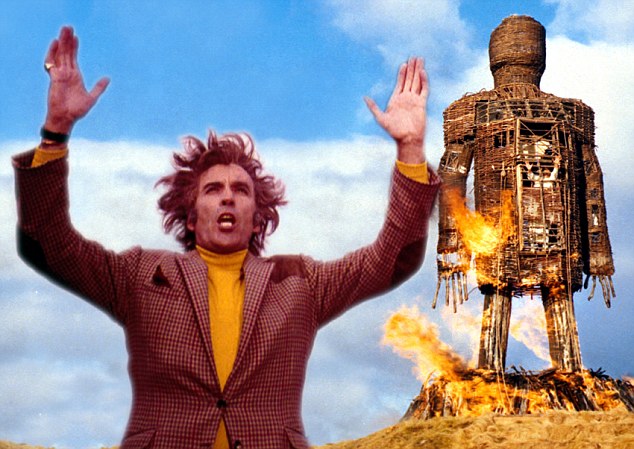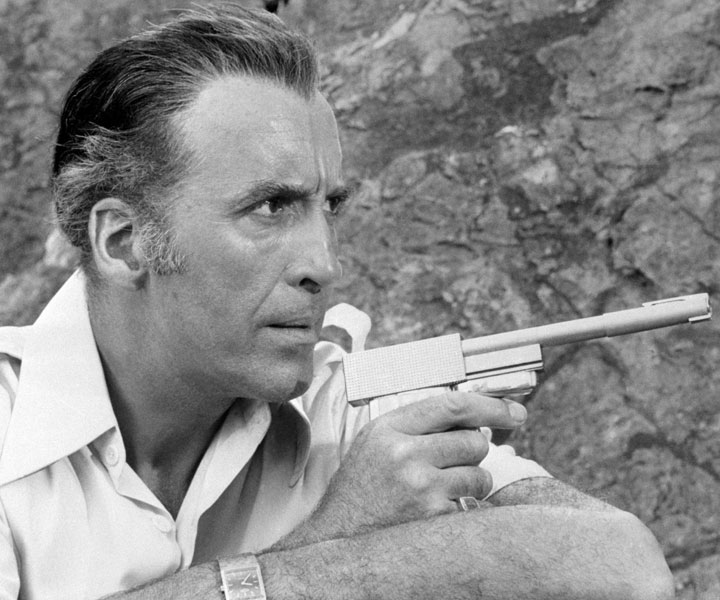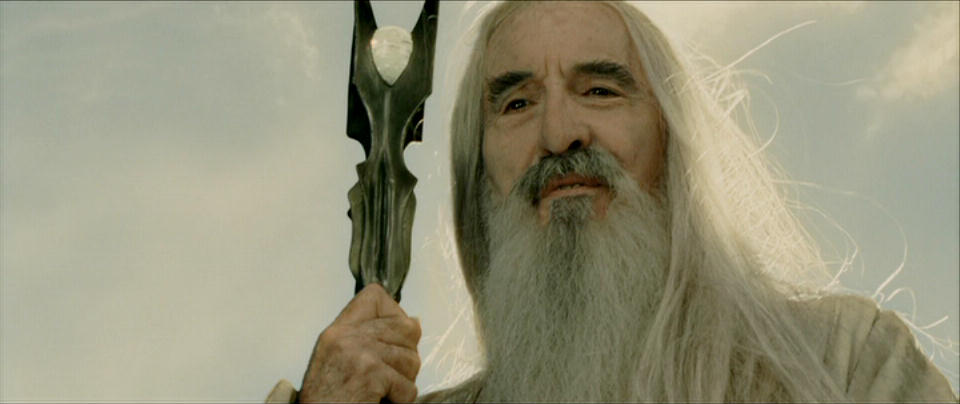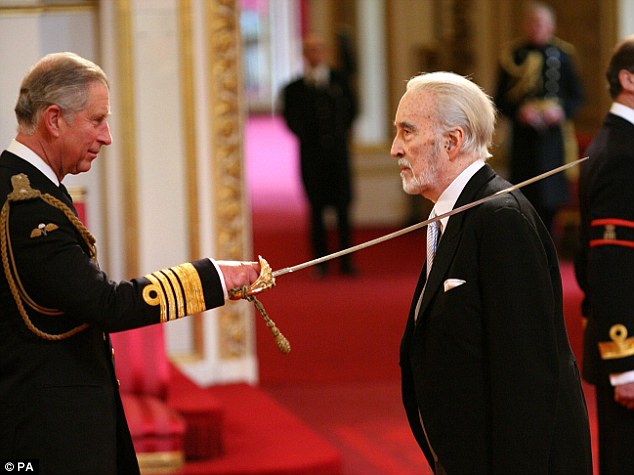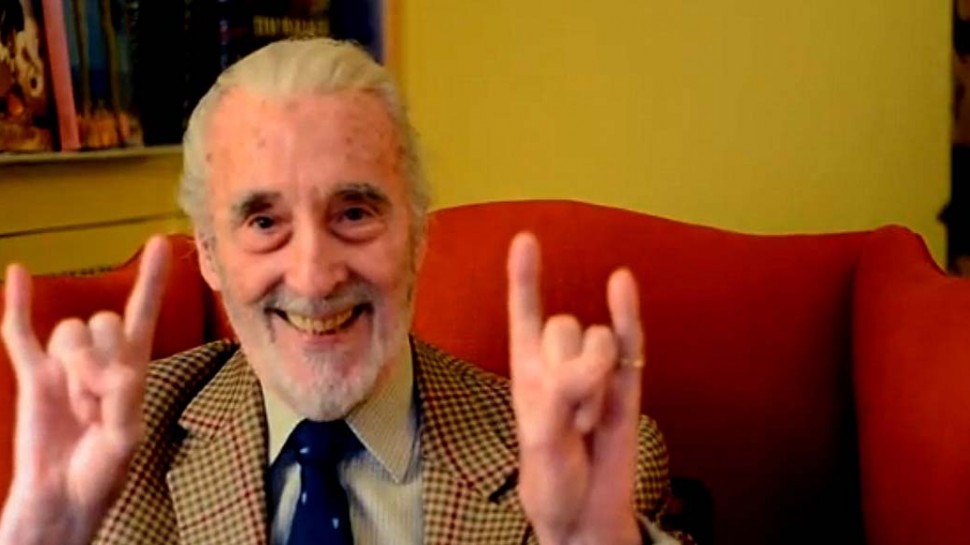
|
The Eleventh Annual Dead Man of the Year Award...
By J.C. Maçek III 

An old and great warrior-king lies dying in his bed...
The 2015 Dead Man goes to the terrifying... How many actors can say that they have contributed (majorly) to such varied franchises as James Bond, Star Wars, The Lord of the Rings, The Howling, Sherlock Holmes, Dracula, Frankenstein, The Mummy and Fu Manchu? Unless I'm suddenly in the midst of a brain-freeze that erases the obvious, I'm thinking the answer is "only one" and that man just happens to be 2015's Dead Man of the Year Award-winner, one Christopher Lee! With a resume like Lee's it's almost obvious that WorldsGreatestCritic.com would recognize him in the very year he died. Seldom does this actually happen. Since we started these in honor of the year 2005, Lee is only the fourth honoree to receive the award for the year he died. This is, of course, because Christopher Lee continued to make incredible waves in the entertainment industry virtually up until the moment of his death. At the age of 93, Lee is, by far, the oldest winner at the time of his death, which is noteworthy because Lee takes the "eldest" cake time after time in his career. In addition to acting until his final year on Earth, Lee also was the oldest ever Heavy Metal musician. He also holds the honor of oldest living musician to have a hit on the Billboard Hot 100 (his 2013 single "Jingle Hell" reached #22 when he was 91 1/2 years of age). Seeing how much of his career was crammed just into the last few years, one might wonder why the artist was suddenly so active. One would be ignorant to ask such a question, however, because Christopher Lee was, in fact, incredibly active throughout his entire life. That life began on May 27, 1922 with the birth of Christopher Frank Carandini Lee. Appropriately for a man who would become incredibly well-known for playing Count Dracula, baby Christopher was born to a Countess. Countess Estelle Marie Carandini di Sarzano (1889–1981) married Lieutenant Colonel Geoffrey Trollope Lee (1879–1941) and brought into the world Lee's older sister Xandra Carandini Lee (1917–2002) followed by Lee himself. The Countess was a descendant of no less a royal figure than King Charlemagne (a lineage that would inform Lee's later career). His great-grandfather on his mother's side was an Italian political refugee and that man's wife, Lee's own great-grandmother was the English opera singer Maria Burgess Carandini. Lee's mother, herself, was a sought-after model who had been painted and sculpted by some of the great artists of her time. Lee's father's side was no stranger to notable feats either with Geoffrey Lee counting membership in the 60th King's Royal Rifle Corps, where he fought in both World War I and the Boer War. If that isn't enough of a warrior image, Geoffrey Lee's side of the family also included Civil War General Robert E. Lee. Alas, the marriage was not to last and the couple divorced (after two years of separation) when Lee was six years old. This began Lee's own world travels. Lee's mother took young Xandra and Christopher to Switzerland where he first got the acting bug playing Rumpelstiltskin while in elementary school. The Countess then married banker Harcourt George St-Croix Rose. Through Lee's stepfather the future star would become the cousin of famed author Ian Fleming. It was not only the future James Bond creator whom Lee would rub elbows with, but also famed actors like Eric Maturin and political notables like Russia's Grand Duke Dmitri Pavlovich and Prince Felix Felixovich Yusupov, the men who would go on to assassinate Grigori Yefimovich Rasputin. Many years later, Lee himself would go on to portray Rasputin on film. Lee attended school with actor Patrick Macnee (with whom he appeared in plays) and studied classic languages Ancient Greek and Latin while at Wellington College. He also studied weapons training and various sports, but did little acting. The work force followed and Lee took on various jobs before his first military service, volunteering to fight for Finland in 1939's Winter War (the Soviet Union's invasion of Finland only three months after World War II began). After this conflict, Lee joined England's Home Guard, followed by the Roayal Air Force. When a "failure of the optic nerve" prevented his further flying for the RAF, Lee applied to join RAF Intelligence and was accepted. Lee traveled the world, was almost killed in North Africa and contracted malaria six times in one year. Lee also improved the morale of the other officers around him and greatly impressed his commanding officers. As the war continued Lee was attached to the Special Air Service (or, rather, its precursor in the Long Range Desert Patrol) in assignments he was forbidden to discuss in any capacity for the rest of his life. It is worth noting that Christopher Lee, the man who would go on to play one of James Bond's most memorable villains practically WAS James Bond in real life. During his military service, Lee was also attached to a certain agency called the Special Operations Executive (SOE) which was also known as "The Ministry of Ungentlemanly Warfare". Sound interesting? It was. The SOE was most assuredly "Ungentlemanly". Winston Churchill tasked the team to "set Europe ablaze". It was here that Christopher Lee actually teamed up with his aforementioned step-cousin Ian Fleming. The team itself operated out of Sherlock Holmes' headquarters. That's not a joke. True, Holmes was a fictional character (whom, indeed, Christopher Lee would portray multiple times), but the Ungentlemen did operate out of Baker Street, exactly where Holmes had in the novels of Arthur Conan Doyle and the SOE was even referred to as "The Baker Street Irregulars". What is more, Ian Fleming based much of the fantastical James Bond stories on his own experiences with this group (which was something of a real-world MI-6) and based many of his characters, such as M, Q, Miss Moneypenny and even Vesper Lynd on actual real people he met and worked with during this time. Dare we speculate that Christopher Lee may have, indeed, partially inspired James Bond himself? It is possible, yes, but again, neither Lee nor Fleming could really talk about it, as these activities remain classified to this day. Because of the hush-hush nature of this super-secret group, we don't really know what Flemming or Lee were involved in, but we do know that the Ministry of Ungentlemanly Warfare (which also went by the badass name of "Churchill's Secret Army") were proficient in weapons and sabotage and the group was involved in organizing resistance groups in occupied France to work with the Allies against the Nazis, working with the Polish government in exile, supporting anti-fascist movements in Italy, distributing secretive propaganda and administrative sabotage within Austria and Germany itself and Operation Gunnerside, in which the Ministry of Ungentlemanly Warfare teamed up with the Norwegian Resistance to create a commando unit that destroyed a heavy water plant that would have been used to allow Germany to create an atomic bomb. That's right, Lee's group prevented Hitler from getting his hands on "the bomb" and, thus, changing the end of the war (and the entire future of our world) forever. That's not to say Lee himself was involved, but because those involved are actually classified, that's also not to say that Lee wasn't involved. What we do know is that Flying Officer (a great title in itself) Christopher Lee retired from the RAF with the rank of Flight Lieutenant after seeing more action than most of us could ever see in a lifetime of movies, including the liberation of Italy and the tracking of Nazi War Criminals (while on loan to the Central Registry of War Criminals and Security Suspects). Lee returned to London and soon returned to acting as well. Yet another famous cousin, Italy's Ambassador to Britain, Nicolo Carandini listened to Lee's war stories and suggested that he become an actor. Though the Countess opposed the decision, Lee won her over by pointing out the number of successful performers the Carandini family had produced including his own great-grandmother. The Ambassador pulled some strings and got Lee in front of producers and studio heads. At a height of six feet four inches, Lee cut an imposing swath and some believed the veteran was just what the film industry needed while others believed he was simply too tall to be an actor. Such dismissive comments emboldened Lee and he was determined to be a success. However, he, like many at the time, had great difficulty finding work. He took a small part in the Gothic romance Corridor of Mirrors (1947), his film debut, in which he had a single line. However, this was far from his "big break in show biz". It was during this time that Lee first met actor Peter Cushing, on the set of Laurence Olivier's Hamlet. Cushing would go on to become one of Lee's dearest friends, a frequent co-star and, indeed, a big part of Star Wars history in his own right (playing Grand Moff Tarkin in the original Star Wars). Impressively, Christopher Lee continued to act, but in small roles. He worked with such notables as Douglas Fairbanks, Jr. and John Houston amongst many others in his almost thirty films in the ten years since his 1947 screen debut. Lee's fortunes failed to improve and caused great pains in his personal life. In short, whether he was the inspiration for James Bond or not, he wasn't quite the Lothario that Bond was. Lee was engaged in the 1950s to Henriette von Rosen, the daughter of Count Fritz von Rosen of Sweden. Her father was against the marriage and hired private investigators to follow Lee and had friends interview him. Lee had to provide personal references (as if he were applying to join the royal family) and finally had to obtain the permission of the King of Sweden to marry his love. The joke was on the Count, however, because Lee was already acquainted with the king due to his filming of a Hans Christian Andersen film years before. Perhaps all of these distractions kept him from focusing on the real problem... the fact that Lee was a starving actor who had no stable, reliable income. Painfully, Lee ended the engagement, telling his once betrothed that she deserved better than to be "pitched into the disheveled world of an actor". It wasn't easy, but Henriette accepted this and called off the wedding. Somewhat ironically for an actor with such a recognizable face and voice, Christopher Lee's big break came in a role for which he did not speak and was practically unrecognizable. That role was Frankenstein's Monster in the Hammer film The Curse of Frankenstein (1957). Also starring Peter Cushing as Victor Frankenstein, Lee's only audition was answering the question "do you want the part" with the word "yes". In spite of Hammer's best efforts to differentiate the film, Universal Studios sued the British company for trampling all over their intellectual properties, namely the Frankenstein films that starred Boris Karloff. Ironically, while this was going on, Lee would star with Karloff in 1958's Corridors of Blood. Hammer continued to make horror films after the success of Curse of Frankenstein and they knew that, in no small part, Cushing and Lee were a big part of that success. Thus Lee was cast in a much more recognizable leading role in their follow-up film, Horror of Dracula (1958) which also saw Cushing as the more heroic Dr. Van Helsing. Horror of Dracula made Lee a bona fide star in his own right and informed a great deal of the Dracula lore we take for granted today. Although a direct descendant of Bela Lugosi's Dracula (1931), Lee's Dracula was among the first big screen vampires to actually bear visible fangs. This was the first of eleven times Lee portrayed Dracula on film over the next two decades. By the time Dracula was making headlines, Universal and Hammer had buried the proverbial hatchet and were working together. Universal was given the lucrative international distribution rights for Hammer's horror films while Hammer was given the rights to remake Universal's Classic Monster Movies. Thus, Lee would go on to star in The Mummy (1959) as well as Hammer's Rasputin, The Mad Monk (1966) and Hammer's The Hound of the Baskervilles (1959) along with more and more Dracula flicks. This would be something Lee would grow to regret. In the first of these, Dracula: Prince of Darkness (1965), Lee would not actually speak onscreen. According to the screenwriter, Jimmy Sangster, there were never any lines written for the character, but according to Lee himself, the script was rife with Dracula dialogue so inane that the now veteran performer refused to deliver the lines and simply hissed throughout the film's runtime. Hammer would consistently draft Lee into playing the Count without being able to offer him his now larger salary. Hammer would first sell the next Dracula film to distributors before it was made, then tell Lee that he had to play the part because of this promise. Ultimately, Hammer resorted to guilting Lee into accepting the role time and again because of the fact that a great number of his close friends would be out of work if he refused to play the part. Further, the subsequent Dracula films showed less and less direct involvement of the Count himself and Lee was annoyed by the waning quality of the films and the screenplays. The only way he could stomach continuing was by slipping in occasional lines written by Bram Stoker but not in the scripts themselves. That said, the films continued to be successful up until the modern-day missteps Dracula A.D. 1972 (1972) and The Satanic Rites of Dracula (1973). But during this time, with his star rising, Lee became known for playing another famed character, one he had quite a connection to in real life: Sherlock Holmes. Although 1959's Hound of the Baskervilles gave us Lee as Baskerville and Cushing as Sherlock Holmes, Lee himself would portray Holmes for the first time in 1962's Sherlock Holmes and the Deadly Necklace (1962). He would go on to play Holmes in Sherlock Holmes and the Leading Lady (1991) and Incident at Victoria Falls (1992). In The Private Life of Sherlock Holmes (1970), Lee did something completely different and played Sherlock's older brother Mycroft Holmes while Robert Stephens took over the role of the detective. Lee credited his turn as Holmes and Holmes as the reason he was no longer typecast as a villain. What a difference a few years made for Lee. Once firmly established as a star actor, Lee met model and artist Birgit Krøncke (nicknamed "Gitte") through Danish friends and the couple married in 1961. One daughter followed in 1963 named Christina Lee. Christina and Christopher would later collaborate, contributing spoken vocals to Italian Heavy Metal Band Rhapsody of Fire's 2011 album From Chaos to Eternity. As if Lee's life wasn't amazing enough, it is also true that the actor spoke no less than eight languages including English (due, in part, to his days in RAF Intelligence). Because of this, Lee was cast as the lead in the German film Das Rätsel der roten Orchidee, AKA: The Puzzle of the Red Orchid (1962), in which he spoke German. Lee was also famous for portraying the villainous Fu Manchu in a series of films beginning with 1965's The Face of Fu Manchu. He reprised the role four more times, ending with 1969's The Castle of Fu Manchu. Although he had already tired of portraying Count Dracula in Hammer's films (though he would still make a couple more), Lee did team up with Hammer and his author friend Dennis Wheatley for the occult films The Devil Rides Out (1967) and To the Devil a Daughter (1976). The latter marked major changes for most involved. Hammer stopped making horror films for quite some time after the 1976 film, Wheatley disowned the project and Lee departed from Hammer, seemingly forever. However, Christopher Lee being Christopher Lee, he was not done with horror in general. The next few years saw his appearances in I, Monster (1971), The Creeping Flesh (1972) and the incomparable horror film The Wicker Man (1973). If you haven't seen it, you really must. The film is genius. Lee's benevolent side may not have shown much onscreen in The Wicker Man, but just as he continued to play Dracula for lower rates, Lee was so dedicated to the low budget 1973 film that he donated his services free of charge. Luckily the investment didn't blow up in Lee's face as The Wicker Man became a cult favorite and is critically acclaimed to this day. However, this can't be said for every risk Lee took. Does the name Jess Franco mean anything to you? It apparently didn't mean much to Lee when he accepted the role of the narrator in Franco's Eugenie (1970). As with most of Franco's films (or, I should say, every single one of them) Eugenie was a soft-core porn film (and I use the term "soft" lightly). Lee had gone to Spain for a single day's work on a set in which every actor had his and her clothes on. However when Eugenie was released friends informed him that he was being billed in an adult film showing in porno theaters in the seediest part of London. Lee laughed it off, but went to the theater heavily disguised and found that Eugenie was not only pornographic, but also had his name in bright and shining lights on the marquee. The actor was furious and Eugenie created a lot of problems for Lee at the time. Apparently when Lee's back was turned, the cast took their clothes off and once Lee left Spain after that one day's work, the sex scenes were filmed. Around that same time, Lee reprised his role as Dracula in the German film Count Dracula (1970), opposite Klaus Kinski as Renfield and Herbert Lom as Van Helsing. Although the film is considered a faithful adaptation of the original Stoker novel, reviews are mixed with many critics deriding it as boring. Incidentally, that director's name was Jess Franco. Once bitten, twice shy? Lee's association with his cousin Ian Fleming continued until Fleming's death in the mid 1960s. While there is some evidence that Lee was at least partially the inspiration for James Bond, he was never in contention for the role of Bond onscreen. He was, however, offered the titular role of Dr. No, by Fleming, in the first Bond film (of the same name), released in 1962. However, it turned out that the producers had already offered the part to Joseph Wiseman, however, Lee's association with his cousin's most famous character didn't end with that misfire. Instead, fresh off the heels of his amazing turn in The Wicker Man, Lee was cast in the titular role of another Fleming-created villain in The Man With The Golden Gun (1974). In this film he played the inventive sharp shooting criminal Francisco Scaramanga. Appropriately, Lee portrayed Scaramanga as "the dark side of Bond", "charming, elegant, amusing, lethal". Lee, as Scaramanga, remains one of the most memorable and excellent James Bond villains of all time. The ingenious gadgets, the secret, technological hideout, the plans for world domination... it's all there and Lee plays the character with a cold, wicked smile. The 1970s were also an era of near misses for Lee. He accepted the role of The Specialist in Ken Russell's film adaptation of The Who's Tommy (1975), but Lee had to drop out due to his filming schedule on Golden Gun in Thailand. The role went to Jack Nicholson. (However, on the Rock and Roll front, Lee did accept an offer to appear on the cover of Wings' Band on the Run album). Similarly, Lee was offered a supporting role as a psychiatrist in a low budget horror film from an independent director. Like his good friend Peter Cushing, Lee turned the role down. Unfortunately for both of them, that little independent horror flick was Halloween (1978) and the director was the brilliant John Carpenter. Halloween went on to become an acclaimed classic that redefined the slasher film and impacted horror for years to come. John Carpenter became a superstar director and Donald Pleasence, who did accept the role of Doctor Sam Loomis, was gifted with one of the most memorable roles of his career. Later, Lee met Carpenter and confessed that turning down that great role was one of the biggest regrets of his entire career. Another "big mistake" in the mind of the actor was his turning down of the role of Dr. Barry Rumack in the disaster spoof Airplane! (1980). That role went on to be famously played by our 2010 Dead Man of the Year Leslie Nielsen in a career-redefining performance. Of course, Lee was only able to turn down such offers because he had decided to beat the typecasting devil altogether by relocating from London to Hollywood. His first American film was Airport '77 (1977, natch), which made him a shoe in to appear in Airplane!. Too bad for him, he didn't. Lee went on to appear on Saturday Night Live (in 1978), in Steven Spielberg's 1941 (1979) and a memorable role in Disney's Return from Witch Mountain opposite Bette Davis where he plays a technological villain with the power to control minds, including that of one of the super-powerful alien kids. Lee actually sang in the musical The Return of Captain Invincible (somewhat forecasting his latter-day Heavy Metal career), co-written by The Rocky Horror Picture Show's Richard O'Brien. After turning down (or having to cancel his appearances in) some really great films, Lee was careful about what he turned down. Perhaps this is what led him to (surprisingly) accept the role of Stefan Crosscoe in the ridiculous horror sequel Howling II: Your Sister Is a Werewolf (1981) also starring Sybil Danning and Reb Brown (if you can believe that). You can read my review for that masterpiece here: 'Howling II' Is a One-of-a-Kind Disasterpiece! But hey, give him some credit, he did also feature in Gremlins II: The New Batch (1990). Lee appeared in a string of both memorable and forgettable roles throughout the next two decades. Let us not forget that he did agree to appear in 1994's Police Academy: Mission to Moscow. However he did also star in a well-respected biopic called Jinnah (1998) in which he played Mohammed Ali Jinna, the founder of modern Pakistan. Lee would later go on record indicating that this was his favorite and most significant performance of his career. One of the more noteworthy appearances was his final collaboration with his friend Peter Cushing in the Hammer Horror documentary Flesh and Blood: The Hammer Heritage of Horror (1994). The duo of old costars and friends co-narrated the film, but it would be their last collaboration and, in fact, meeting as cushing died two months after the recording of the narration. Lee's villainous side was almost seen as the mutant leader Magneto in the film X-Men, but that part went to Ian McKellen. However, Lee's fortunes were about to change considerably thanks, in part, to that same man. Among the many legendary figures Christopher Lee met in his life was one J.R.R. Tolkien and, in fact, Lee had long dreamt of portraying the heroic wizard Gandalf on screen. By 1998 when Peter Jackson finally managed to get the Lord of the Rings film trilogy greenlit, Lee was seventy-six years of age and a bit too old to play the character, considering the physical demands of the role. Once again, the coveted role Lee had his eye on went to his friend Ian McKellen. However, Lee was given the similar role of turncoat wizard Saruman the White, for which he received much acclaim. The first film in the trilogy, The Fellowship of the Ring was released in 2001, while the next two The Two Towers and The Return of the King were released in 2002 and 2003 respectively. His casting as Saruman gave Lee a much deserved career resurgence that made him a bonafide superstar once again. In 20015 Lee was named the most marketable star in the world by USA Today. Tolkein's trilogy wasn't the only one he would find himself involved in. 2002 also saw Lee's first appearance as the Dark Lord of the Sith Darth Tyranus in George Lucas' Star Wars Episode II: Attack of the Clones. With his public guise as former Jedi Count Dooku (named, in part, for Count Dracula), Lee's character proved to be an integral part of the duplicitous rise of the Empire and the fall of the Old Republic. He would reprise his role as Tyranus/ Dooku in both Star Wars Episode III: Revenge of the Sith (2005) and the animated Star Wars: The Clone Wars (2008) for which he lent his voice. Amazingly, considering the fact that he was over eighty years old when filming his scenes, Christopher Lee performed most of his own sword fighting. For some wide shots a double had to be used. Lee stated "my arms and hands will move as fast as you saw them" but confessed that his legs could no longer move that fast. Clone Wars was hardly unique in Lee's career, as he had long been a voice actor who used his unique bass vocals to accentuate animated films in multiple languages. This includes his characterization of King Haggard in both the English and the German versions of The Little Unicorn (1982). In live action, he lent his voice to the 1965 film adaptation of Agatha Christie's Ten Little Indians. He also portrayed the voice of DEATH in multiple productions. His video game work includes appearances in the Kingdom Hearts saga, EverQuest II and The Lord of the Rings: Battle for Middle-earth in which he reprised his role as Saruman. He further revisited the role of Scaramanga in the video game GoldenEye: Rogue Agent. Lee also lent his voice to Tim Burton's Alice in Wonderland (2010), The Nightmare Before Christmas (1993) and Corpse Bride (2005). In live action, Lee would team with Burton on such films as Sleepy Hollow (1999), Dark Shadows and Charlie and the Chocolate Factory (2005). By the time of the mid 2000s, Lee was an unquestionable star again and was highly in demand. EntertainmentWeekly magazine referred to him as the "IT really, really Old Guy". They were not wrong, but Lee was hardly slowing down. Lee teamed with director Martin Scorsese for the critically acclaimed film Hugo (2011) and even managed to appear in the sequel to The Wicker Man known as The Wicker Tree (2011). Also in 2011, Lee returned to Hammer Films for the first time in thirty-five years to make The Resident alongside Hilary Swank and Jeffrey Dean Morgan. It would be Peter Jackson who once again beckoned Christopher Lee to blockbusters when he reprised his role as a pre-bad guy Saruman for The Hobbit: An Unexpected Journey (2012) and The Hobbit: The Battle of the Five Armies (2014). Counting video games like Return of the King, The Third Age, the aforementioned Battle for Middle-Earth, Battle for Middle Earth II and Lego The Hobbit, Lee would play Saruman no less than eleven times. With a life this rich and well-lived, Lee could have died then and still have been a legend, but the man who would be Count had more worlds yet to conquer. Lee had long been a singer, contributing vocals to The Wicker Man soundtrack as well as the aforementioned Captain Invincible film and the horror film Funny Man (1994). He further appeared on the concept album The King of Elfland's Daughter (1977) and the disco song "Little Witch". But his big break in music came in the form of a very unlikely genre. Invited by Italian singer Fabio Lione to duet on Rhapsody of Fire's single "Magic of the Wizard's Dream" (2005), Lee began a series of collaborations with the band. In total he appeared on six of the band's albums. From there, Lee caught the Heavy Metal bug, so to speak, and collaborated with the band Inner Terrestrials to record a metal version of "Toreador Song" from the opera Carmen in 2006. He also joined with metal band Manowar for their re-recording of the album Battle Hymns (the new version being called Battle Hymns MMXI (2010). By this time, however, Lee was keen on releasing his own Heavy Metal album, which he did. At eighty-eight years of age, Lee was by far the oldest Heavy Metal musician the world had ever seen and, appropriately, he reached back into his own family history for the award-winning metal album Charlemagne: By the Sword and the Cross (2010), which told the tale of his most famous ancestor. Lee would revisit the subject matter in an even heavier album called Charlemagne: The Omens of Death (2013) on which he collaborated with guitarists Hedras Ramos and Judas Priest's Richie Faulkner! This was no mere novelty, as in December of 2012, Lee released A Heavy Metal Christmas, an EP of metal covers, which was followed in 2013 by A Heavy Metal Christmas Too. It was the single "Jingle Hell" from this second EP that helped Lee make history once again. At ninety-one and one half years old, Lee became the oldest living performer, of any genre, ever to enter the Billboard Charts when "Jingle Hell" debuted at #22. The song climbed several notches to #18 before it was done. Lee continued to record and release music with 2014's Metal Knight, another collection of cover songs that included the aforementioned Carmen song, a cover of "My Way" (made famous by Frank Sinatra) and a couple of songs from Man of La Mancha because, according to Lee, "Don Quixote is the most METAL fictional character I know". Lee's final release came in December 2014 with Darkest Carols, Faithful Sing in which he, again, released metalized Christmas songs. Lee's final musical recording came when Lee collaborated with The Hollywood Vampires for the song "The Last Vampire" (where he was joined by Alice Cooper, Joe Perry and Johnny Depp. The album also featues such greats as Brian Johnson, Robby Krieger, Joe Walsh, Slash, Dave Grohl and Paul McCartney. It should be noted that the original Hollywood Vampires consisted of Bob Brown, Mickey Dolenz, Harry Nilsson, Ringo Starr, Keith Moon, John Lennon and Alice Cooper (which gave him rights to the name). Thus, Christopher Lee was included not only in Horror Royalty but Rock Royalty as well. Why get so involved in Heavy Metal, especially so late in life (at an age no one else, to date, had ever been involved in the genre)? According to lee it was all "light-hearted, joyful and fun." By this time, Lee wasn't sure how much longer he might live, so he celebrated every day and shared that celebration with his fans. "At my age, the most important thing for me is to keep active by doing things that I truly enjoy." And Heavy Metal was something Christopher Lee truly enjoyed. Unfortunately the collaboration with the Hollywood Vampires was to be his last contribution to music or just about anything else artistic. Lee was still celebrating his ninety-third birthday (four days before) when he was admitted to Chelsea and Westminster Hospital on June 7, 2015 with resperatory issues and heart failure. His wife Gitte delayed the announcement until June 11 in order to inform friends and family. Lee is survived by Christina and Gitte. Lee died not only a legend in movies and television but also in warfare and espionage as well as a record-setter in the world of music. He was Knighted by Prince Charles in 2009 and carried appointments as Commander of the Venerable Order of Saint John, Commander of the Order of the British Empire and France's Commander of the Order of Arts and Letters. He received a BAFTA Academy Fellowship, an honorary membership in the UCD Law Society, a Bram Stoker Gold Medal and a copy of M.R. James' Collected Ghost Stories (Lee had both met James in person and had played him on BBC Television). The impact of Christopher Lee is still being felt in the year 2015. Lee's films in any genre have remained some of the most popular ever made. Battle of the Five Armies was re-released for one night only in October 2015 and made a big splash on Blu-Ray in 2015. Lee also appeared in two 2015 films, Extraordinary Tales and Angels in Notting Hill. His films are still being enjoyed in theaters and on home video. 2015 also showed new entries into the Star Wars and James Bond films, both of which he contributed greatly to. Lee's music is also being discovered and rediscovered as the years go on. Christopher Lee was truly one of a kind. An innovator and artist whose direct and indirect impact on the world of movies (and much more) is felt every day. Farewell, nightmare maker, metal god, spy, knight, hero, villain, actor, singer and all around amazing human being. You have left us but you're never truly gone. Rest in Peace, Mr. Lee.
Sir Christopher Lee
|
Sink your teeth into more WorldsGreatestCritic.com by clicking HERE for reviews and everything else under the moon. The 2015 World's Greatest Critic's Dead Man of the Year Awarded to Sir Christopher Lee! This article was written and researched by J.C. Maçek III who is solely responsible for the content of all of this website Including the final decision of unparalleled awardee year after year. Nominate yours for 2016 now... I'm sure you can scare a few up! Got something to say? Write it!
| By the Sword and the Cross (2010) |


